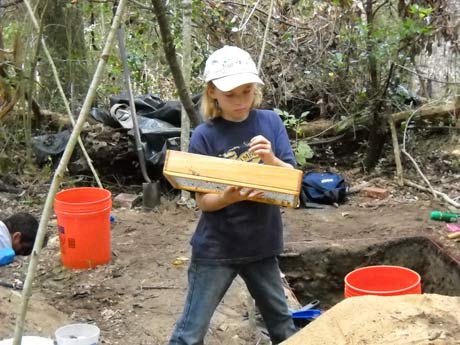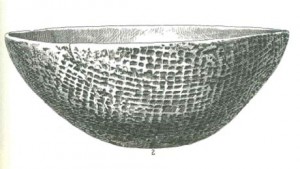A Visit to Northeast Florida’s Compelling Past
Get up close and personal with centuries of history with the archaeological sites found along the William Bartram Scenic & Historic Highway. There’s nothing like experiencing the past while savoring a scenic drive on Northeast Florida’s most beautiful stretch of roadway. Pull off and immerse yourself in sites of continued historical interest.
In so many ways, the historic places to see and experience here are a hidden jewel of the First Coast’s archaeological legacy. Take a trip beyond the beaten path to discover them for yourself!
The 37 archaeological sites identified within the corridor reveal over 4,500 years of human attraction to the river. The majority of recorded sites have prehistoric, Native American components (27). The mounds, shell middens, and habitation sites ubiquitous along the river reflect tens-of-thousands of lives lived along its banks. From the earliest pottery makers of the Orange Period (2,500 – 1000 BC), through the arrival of the Spanish missionaries (1573 – 1700s) and the development of orange grove plantations in the Victorian Period, many cultures with different resource and economic strategies, and different political and religious worlds, have inhabited this region and are represented in the archaeological record.
Though these sites must be viewed in a regional perspective and are each important to the larger picture, there are certain sites that are of particular significance due to how much information still remains in the ground from the original occupation. These sites have been designated as Potentially Eligible for listing on the National Register of Historic Places and are in need of additional research. These 5 sites include:
- Site 8SJ3211, as reported in the Archaeological and Historical Resources of the Riverton DRI*, is a prehistoric site that contains a series of cultural occupations from the Transitional Period (1,000 BC to 500 BC) when new horizons of technology, settlement, and and political forms developing into the St. Johns I Period (500 BC to AD 800). “Later occupation may also have taken place as evidenced by the presence of St. Johns Check Stamped pottery (a post A.D. 800 indicator) and the possible Pinellas projectile point.”
- Site 8SJ3218, as reported in the Archaeological and Historical Resources of the Riverton DRI*, constitutes a 14-acre site which occupies almost the entire western margin of Popo Point. At this site recovered cultural materials include “aboriginal ceramic wares and lithic specimens. Aboriginal pottery includes St. Johns period ceramics, fiber tempered wares, and San Marcos decorated pottery.” This recovered data further suggests “a long temporal continuum of aboriginal occupation possibly beginning as early as 2000 B.C. and continuing past A.D. 1700.” “A most important point and view of the occupation…is that the aboriginal ceramic assemblage is dominated by San Marcos wares, indicating activity by migrant Guale Indians during the late 1600’s or possibly early 1700’s.” This was a time of great upheaval for Native populations being subsumed by European settlement. Of great importance is the presence of early Spanish and British artifacts. The site is most likely the site of the Franciscan San Diego de Salamatoto mission, established by 1606 to Christianize Timucuan populations along the river. It was also a key land mass that served as a major river crossing point and so was defended by all colonial interests. This site is most likely one of the most important historical sites within St. Johns County.
- Site 8SJ3220, as reported in the Archaeological and Historical Resources of the Riverton DRI*, encompasses a 10-acre site along the eastern edge of Hallowes Cove. “This intact, multi-component site contains both historic and prehistoric materials.” And, the materials of “Aboriginal ceramic materials include Orange Plain, St. Johns Plain, St. Johns Check Stamped, St. Johns Simple Stamped…unidentified sand-tempered sherds, …and small flakes…which were thermally altered. Historic materials include 18th and 19th century artifacts” as well. Presumably, this site was “occupied intermittently during aboriginal times” including a Mount Taylor period initial occupation, perhaps, as early as 2000 B.C. The early historic component may represent a late 18th/early 19th century plantation occupation, but data from this component is considered insufficient to assess the potential significance of this component.” Additional work is needed.
- Site 8SJ2459, named the Mill Creek Bluff site, is located at the confluence of Mill Creek, Cunningham Creek and the St. Johns River. It is approximately one half mile west of SR 13. According to the Archaeological Resources Assessment Survey of State Road 13 that commences from Race Track Road to Roberts Road in St. Johns County, Florida, this site has been described as potentially significant and is thought to relate to the St. Johns period (500 B.C. – A.D. 100). It has been speculated that this site may be part of a very large, permanent village positively linked to the “Fruit Cove Mounds” (8SJ15 and 8SJ16) located along Cunningham Creek. Clarence B. Moore originally investigated these sites in the 1880’s.
- Site 8SJ2458, named the Historic Mill Site, is located on Mill Creek to the west of SR 13. According to the Archaeological Resources Assessment Survey of State Road 13 commencing from Race Track Road to Roberts Road in St. Johns County, Florida, the site “appears as an earthen dam associated with the creek and is thought to date to the late eighteenth or early nineteenth century.”
* As required by the state for review of a Development of Regional Impact (DRI), Riverton Developers presented the 1989 survey. This developer recently resumed the DRI review process for this project now known as Rivertown, which was approved on February 24, 2004.
Also, the 1989 archaeological survey identified eight prehistoric sites within close proximity of each other along the St. Johns River. Debate continues whether these sites collectively have significance as constituting a large village area. These sites, south of the four mounds near Switzerland, originally were investigated in 1894 by Clarence B. Moore.
Interpretive signage located at significant corridor points will relate the prehistoric and historic uses of the corridor and the St. Johns River. And the Corridor Group will seek opportunities to research and preserve the historical and archaeological resources in the corridor.


